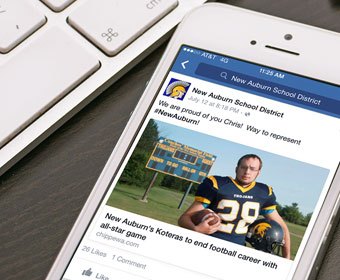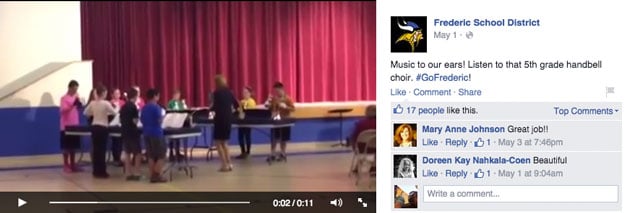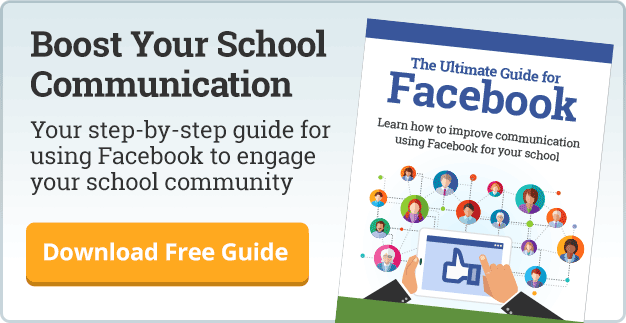Nearly all schools are embracing social media these days. Some districts do a great job and deserve an 'A' on their report card. Other districts, well, let’s just say they don’t meet expectations. Some shortfalls stem from a state of information overload. With new social media platforms popping up every week, where should you focus your attention?
Facebook. It is still king. While Twitter is coming on strong for schools, Facebook is a great way to reach your entire community with school news and updates.
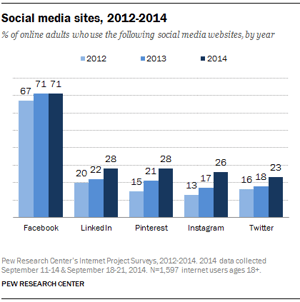 And contrary to what others might say, your students are still using the platform. 71% of teens ages 13 to 17 report using Facebook. The older generation is on there too; statistics show 56% of Internet users age 65 and older use it.
And contrary to what others might say, your students are still using the platform. 71% of teens ages 13 to 17 report using Facebook. The older generation is on there too; statistics show 56% of Internet users age 65 and older use it.
So how does a school make the most out of this platform? What makes a great Facebook page?
After working with more than 30 schools on social media training and directly posting thousands of posts for nine districts, I’ve discovered some principles for success. While there may not be a “magic formula,” there certainly are strategies that can maximize your reach with Facebook. This ultimately gives you a bigger audience to celebrate your amazing students and dedicated staff!
I've broken it down into seven key elements that go into creating the perfect school Facebook page. After reading through the list, I encourage you to evaluate your school page and choose one or two action steps to implement right away to make an even bigger impact during the 2015-2016 school year.
1. Nail your profile picture
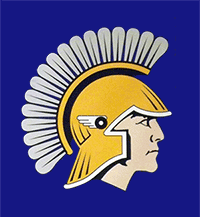 The most important image you select for your Facebook page is the profile picture. Once selected, this image should never change. It represents your school and your brand. Does this make you nervous? It shouldn’t. Choose a high-resolution version of your logo that showcases your school colors. I recommend selecting a version with a logo image only and not one with a lot of text associated with it.
The most important image you select for your Facebook page is the profile picture. Once selected, this image should never change. It represents your school and your brand. Does this make you nervous? It shouldn’t. Choose a high-resolution version of your logo that showcases your school colors. I recommend selecting a version with a logo image only and not one with a lot of text associated with it.
Since more than half of your fans access Facebook from their mobile devices, you want to ensure your small dot of a profile photo is recognizable by your fans, who are quickly scrolling through their newsfeed. By keeping this image consistent, they will begin to recognize it and hopefully it will elicit an eagerness to check out what is happening at your school.
2. Keep cover photo fresh
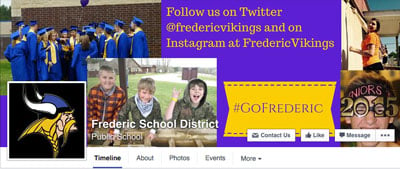
The second most important image on your page is your cover photo, or banner. This image, unlike the profile picture, should be changed on a routine basis. The cover photo should highlight students and staff, and shouldn’t be a boring picture of your school building.
Changing this cover photo on a monthly or quarterly basis is preferable. It gives you the opportunity to include activities and current events in the photos as well as feature different students and staff. Sharing a graduation photo from 2015 at the start of the new school year is not relevant. Showcasing fall sports, students with backpacks, and buses would be more appropriate.
Useful Tip: One great tool to create fun collages including photos and text is www.canva.com. Why do I love it? First of all, it’s free. Second of all, Canva gives you a template to work from that is already the correct size. Simply select the social media image you are trying to create – in this case a Facebook Cover Photo – and you are good to go! It even shows you where that profile picture is going to cover up the image when displayed within Facebook.
3. Post frequently
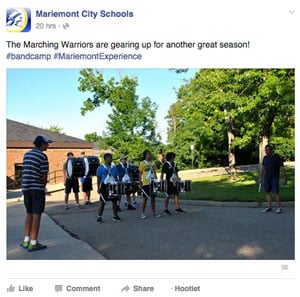 Post frequently to your Facebook page to keep your followers paying attention. You have an audience that craves photos, updates and reminders. Posting 20-25 times per week should be your goal. Yes, that means about three times per day, every day of the week!
Post frequently to your Facebook page to keep your followers paying attention. You have an audience that craves photos, updates and reminders. Posting 20-25 times per week should be your goal. Yes, that means about three times per day, every day of the week!
The key to grabbing that much content is to get everyone in the school involved in submitting photos. Staff members and students should have a method to submit photos to the person (or team) in charge of updating the school Facebook page. These images can then be scheduled for sharing with your district audience over time.
Because of the way that Facebook works, each post that you make doesn’t necessarily make it to every fan’s newsfeed. To keep your page on the good side of the algorithm, you want to post throughout the day and week. Since most Facebook fans are online between 8:00 and 9:00 p.m., posting important reminders and events in the evening is key.
Quick Tip: There should be an endless list of things to share on your page. Seriously, just a smiling face on a student is newsworthy for Facebook. But if you need some ideas, here are a few:
- Faculty Fun Facts
- Funny quotes heard from your students
- Daily lunch menu
- #TBT – Throwback Thursday posts of old yearbook pictures
- Video series on what students love most about your school
- Favorite books that students have read
- Daily questions from different classrooms
- Fundraiser announcements
- Links to articles that help enhance learning at home
4. Allow and monitor comments
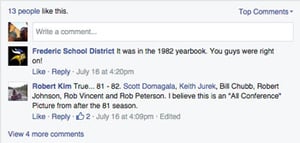 The whole purpose of social media is to be…. SOCIAL! If you limit your Facebook page to just posting but don’t allow comments from your fans, you are missing a great opportunity. Your fans have a lot of positive things to say about your school and you need to let them say it.
The whole purpose of social media is to be…. SOCIAL! If you limit your Facebook page to just posting but don’t allow comments from your fans, you are missing a great opportunity. Your fans have a lot of positive things to say about your school and you need to let them say it.
One school celebrated a teacher receiving a prestigious award from the state level and there were more than 80 comments congratulating her. Of course, this was great feedback for this individual, but even more, it reflected well on the entire district.
Parents, students, co-workers and even past students took the time to sing some praises. If you’re worried about negative comments, you are not alone. Many districts are initially fearful. I have found that over 99% of the comments are positive, but what is the best way to handle those that are not?
Within the settings menu, you can select to be notified every time a comment is made on your page. You can review it and take action if something is inappropriate. With the profanity filter set to high, you don’t have to worry about foul language showing up on your page either. Facebook won’t allow those comments to go live.
5. Schedule reminders
Today’s society is busy. People need reminders and Facebook allows you the chance to give it to them automatically. With each late start, early dismissal, music program and fundraising event, you should prompt your fans with a little reminder.
Are events on your school calendar on the website and in your newsletter? Of course they are. But your audience isn’t on your calendar every day. They are on Facebook.
Meet them where they are!
Quick Tip: At the beginning of each month, set aside 30 minutes to schedule reminders. Make sure to use an image with each one as well. I recommend putting a reminder about a week or two in advance of the event and then always the day before. Your fans will appreciate it and attendance at these events should increase.
Within Facebook, you can schedule up to six months in advance. If you know about them now, I would get reminders posted. You can always review any scheduled posts to modify, change or delete them as the date gets closer.
6. Use video
Facebook places a huge priority on native video posts. What does native mean? It means videos uploaded directly on your Facebook page (from your desktop computer, tablet or smartphone) and not through a YouTube or Vimeo link. Facebook is more likely to deliver a native video to a fan’s newsfeed versus a link to a video hosted on one of these other platforms.
Post videos, and I promise you will see your reach increase. With the auto-play feature, where the video starts automatically in someone’s newsfeed, the animated activity is likely to grab the attention of your audience.
Just try it, and remember the videos don’t need to be elaborate, long, well-edited productions. Sharing a short 10-second video of a first-grader reciting how to spell B-E-A-U-T-I-F-U-L or a 30-second clip of a senior sharing his or her plans for life after graduation is all it takes. And since everyone now has a video camera in the palm of their hand with smartphones, it should be easy to capture these little moments that can mean big exposure for your school.
7. Track results
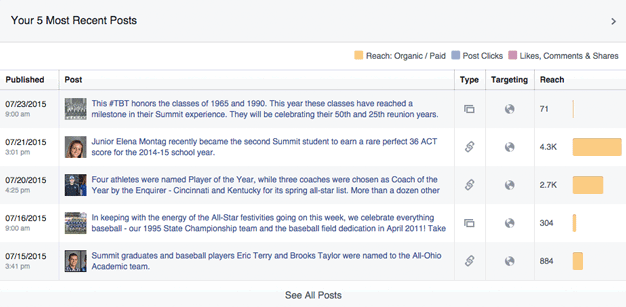
Measuring the success of your efforts is critical, and luckily Facebook makes this aspect pretty easy! As soon as your page receives over 30 “likes,” you will have access to a tab called “Insights.” While it can get a little overwhelming, there are a few numbers you should pay attention to.
The overview tab lists page likes, post reach and engagement right at the top. The percentages right below the number will show the improvement or decline of the current seven-day window of time versus the previous seven days. Green numbers are good, red numbers are not so good. Watching these numbers is a great way to measure progress.
The center section will display the performance of your five most recent posts. It’s interesting to see how some posts reach more people than others. This clues you in to that algorithm Facebook uses and should suggest the post types that perform well with your audience. You’ll notice that videos and powerful images will usually get the highest reach.
The bottom portion of the overview tab is the most important. The “pages to watch” section allows you to select other school pages to monitor and track. You can see at a glance the total number of likes and look at their number of posts and engagement level from the week.
Add it all up, and grade yourself
I’m a competitor, so this feature is crucial for the districts I work with. It shows how your school’s page measures up versus other districts. It can be very helpful to share this information with your administrative team and school board on a quarterly basis. Your efforts on the first six items in this article should be evident in how you stack up.
There you have it, seven solutions to create the perfect Facebook page for your school district. While you're examining your Facebook presence, check out Steve Williams' article 5 Ways to Improve your School's Facebook Page. He has some great pointers on the subject as well.
Have these strategies worked for you? Perhaps you have an additional technique that has boosted your success. Shout it out below.
Topics: Communication School Districts Private schools Social media
About the author
Campus Suite blog contributor Andrea Gribble, founder of SocialSchool4Edu.com, is a social media consultant who is passionate about helping schools celebrate their students and connect communities through social media. You can reach her at andrea@socialschool4edu.com.
.png?width=64&height=63&name=Group%20(4).png)
.png?width=66&height=64&name=Group%20(5).png)
.png?width=56&height=60&name=Group%20(6).png)
.png?width=66&height=52&name=Group%20(7).png)
.png?width=56&height=56&name=Group%20(9).png)
.png?width=59&height=52&name=Group%20(10).png)
